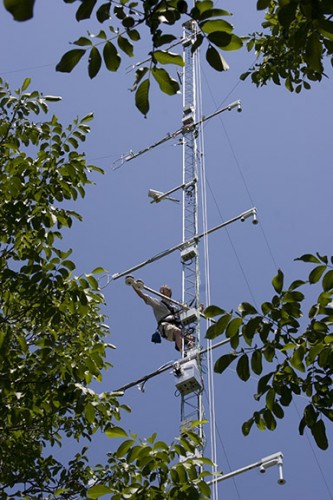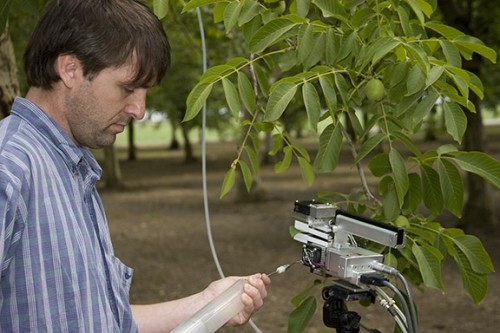No trees have not become sentient, and no we have no worries that our new leafy overlords will soon be punishing us for our many crimes against them. But scientists have discovered that walnut trees respond to stress by producing significant amounts of a chemical form of aspirin. Not only that they produce this chemical when under stress but that they might be telling other trees around that they had better get ready for trouble.

The finding, by scientists at the National Center for Atmospheric Research (NCAR) in Boulder, Colo., opens up new avenues of research into the behavior of plants and their impacts on air quality, and also has the potential to give farmers an early warning signal about crops that are failing.
“Unlike humans, who are advised to take aspirin as a fever suppressant, plants have the ability to produce their own mix of aspirin-like chemicals, triggering the formation of proteins that boost their biochemical defenses and reduce injury,” says NCAR scientist Thomas Karl, who led the study. “Our measurements show that significant amounts of the chemical can be detected in the atmosphere as plants respond to drought, unseasonable temperatures, or other stresses.”
For years, scientists have known that plants in a laboratory may produce methyl salicylate, which is a chemical form of acetylsalicylic acid, or aspirin. But researchers had never before detected methyl salicylate in an ecosystem or verified that plants emit the chemical in significant quantities into the atmosphere.
The team of scientists reported its findings last week in the journal Biogeoscience. The research was funded by the National Science Foundation (NSF), NCAR’s sponsor.
“Biosphere-atmosphere interactions are important to the understanding of the Earth system,” said Cliff Jacobs, program director in NSF’s Division of Atmospheric Sciences. “This fortuitous discovery of methyl salicyclate in quantities not anticipated adds to an already important study.”
Researchers had not previously thought to look for methyl salicylate in a forest, and the NCAR team found the chemical by accident. They set up specialized instruments last year in a walnut grove near Davis, Calif., to monitor plant emissions of certain volatile organic compounds (VOCs).
These hydrocarbon compounds are important because they can combine with industrial emissions to affect pollution, and they can also influence local climate.
When the NCAR scientists reviewed their measurements, they found to their surprise that the emissions of VOCs included methyl salicylate.
The levels of methyl salicylate emissions increased dramatically when the plants, which were already stressed by a local drought, experienced unseasonably cool nighttime temperatures followed by large daytime temperature increases.
Instruments mounted on towers about 100 feet above the ground measured up to 0.025 milligrams of methyl salicylate rising from each square foot of forest per hour.
Karl and his colleagues speculate that the methyl salicylate has two functions. One of these is to stimulate plants to begin a process known as systemic acquired resistance, which is analogous to an immune response in an animal.
This helps a plant to both resist and recover from disease. The methyl salicylate also may be a mechanism whereby a stressed plant communicates to neighboring plants, warning them of the threat. Researchers in laboratories have demonstrated that a plant may build up its defenses if it is linked in some way to another plant that is emitting the chemical.
Now that the NCAR team has demonstrated that methyl salicylate can build up in the atmosphere above a stressed forest, scientists are speculating that plants may use the chemical to activate an ecosystem-wide immune response.
“These findings show tangible proof that plant-to-plant communication occurs on the ecosystem level,” says NCAR scientist Alex Guenther, a co-author of the study. “It appears that plants have the ability to communicate through the atmosphere.”
The discovery raises the possibility that farmers, forest managers, and others may eventually be able to start monitoring plants for early signs of a disease, an insect infestation, or other types of stress. At present, they often do not know if an ecosystem is unhealthy until there are visible indicators, such as dead leaves.
“A chemical signal is a very sensitive way to detect plant stress, and it can be an order of magnitude more effective than using visual inspections,” Karl says.
“If you have a sensitive warning signal that you can measure in the air, you can take action much sooner, such as applying pesticides. The earlier you detect that something’s going on, the more you can benefit in terms of using less pesticides and managing crops better.”
The discovery also can help scientists resolve a central mystery about VOCs. For years, atmospheric chemists have speculated that there are more VOCs in the atmosphere than they have been able to find. Now it appears that some fraction of the missing VOCs may be methyl salicylate and other plant hormones.
This finding can help scientists better track the impact of VOCs on the behavior of clouds and the development of ground-level ozone, an important pollutant.

FINDING ADEQUATE ENOUGH WAYS OF WARNING EACH OTHER IN THE HUMAN COMMUNITY OF IMPENDING DANGER.
We in the family of humanity are going to be forced to do better in our efforts to communicate in a more reality-oriented way about ominously looming threats of an human-driven, global calamity of some kind. If we keep doing precisely what our leaders are saying and doing now, the future for our children looks bleak. We can surely do more and do it better. After all, human beings are remarkably intelligent, ingenious and adaptive.
Before we can determine what new and different to do, perhaps a brief analysis of our current, distinctly human-induced, global predicament is in order. Consider for a moment some of the ways in which my generation of leaders has gone so terribly wrong.
First, the leaders in my generation of elders wish to live without having to accept limits to growth of seemingly endless economic globalization, of increasing per capita consumption and skyrocketing human population numbers; our desires are evidently insatiable. We choose to believe anything that is politically convenient, economically expedient and socially agreeable; our way of life is not negotiable. We dare anyone to question our values or behaviors.
We religiously promote our widely shared and consensually-validated fantasies of `real’ endless economic growth and soon to become unsustainable overconsumption, overproduction and overpopulation activities, and in so doing deny that Earth has limited resources and frangible ecosystems upon which the survival of life as we know it depends.
Second, my not-so-great generation appears to be doing a disservice to everything and everyone but ourselves. We are the “what’s in it for me generation.” We demonstrate precious little regard for the maintenance of the integrity of Earth; shallow willingness to actually protect the environment from crippling degradation; lack of serious consideration for the preservation of biodiversity, wilderness, and a good enough future for our children and coming generations; and no appreciation of the vital understanding that humans are no more or less than magnificent living beings with “feet of clay.”
Perhaps we live in unsustainable ways in our planetary home; but we are proud of it nonetheless. Certainly, we will “have our cake and eat it, too.” We will own fleets of cars, fly around in thousands of private jets, live in McMansions, exchange secret handshakes, frequent exclusive clubs and distant hideouts, and risk nothing of value to us. We will live long, large and free. Please do not bother us with the problems of the world. We choose not to hear, see or speak of them. We are the economic powerbrokers, their bought-and-paid-for politicians and the many minions in the mass media. We hold the much of the world’s wealth and the extraordinary power great wealth purchases. If left to our own devices, we will continue in the exercise of our `inalienable rights’ to outrageously consume Earth’s limited resources; to recklessly expand economic globalization unto every corner of our natural world and, guess what, beyond; and to carelessly consent to the unbridled global growth of human numbers so that where there are now 6+ billion people, by 2050 we will have 9+ billion members of the human community and, guess what, even more people, perhaps billions more in the distant future, if that is what we desire.
We are the reigning, self-proclaimed masters of the universe….. the thousands of greedy little kings of capital concentration, big business potentates and governmental sinecurists. We enjoy freedom and living without limits. Of course, we adamantly eschew any talk of the personal responsibilities that come with the exercise of personal freedoms or discussions of the existence of biophysical limitations of any kind.
We deny the existence of human limits and Earth’s limitations.
Please understand that we do not want anyone presenting us with scientific evidence that we could be living unsustainably in an artificially designed, temporary world of our own making….a manmade world filling up with gigantic enterprises, virtual mountains of material possessions, and boundless amounts of filthy lucre.
Third, most of our top rank experts appear not to have found adequate ways of communicating to the family of humanity what people somehow need to hear, see and understand: the rapacious dissipation of Earth’s limited resources, the relentless degradation of the planet’s environment, and the approaching destruction of the Earth as a fit place for human habitation by the human species, when taken together, appear to be proceeding at breakneck speed toward the precipitation of a catastrophic ecological wreckage of some sort unless, of course, the world’s colossal, ever expanding, artificially designed, manmade global political economy continues to speed headlong toward the monolithic `wall’ called “unsustainability” at which point the runaway economy crashes before Earth’s ecology is collapsed.
Who knows, perhaps we can realistically and hopefully hold onto the expectation that behavioral changes in the direction of sustainable production, per human consumption, and propagation are in the offing…..changes that save both the economy and the Creation.
Steven Earl Salmony
AWAREness Campaign on The Human Population, established 2001
http://sustainabilitysoutheast.org/index.php